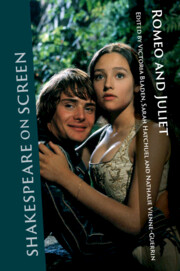Book contents
- Shakespeare on Screen: Romeo and Juliet
- Series page
- Shakespeare on Screen: Romeo and Juliet
- Copyright page
- Dedication
- Contents
- Figures
- Notes on Contributors
- Series Editors’ Preface
- Acknowledgements
- Chapter 1 Introduction – From Canon to Queer: Romeo and Juliet on Screen
- Part I Revisiting the Canon
- Chapter 2 The Italian Job: Franco Zeffirelli’s Romeo and Juliet and the 1960s
- Chapter 3 The Anguish of Youth in Film Adaptations of Romeo and Juliet
- Chapter 4 Aquatic and Celestial Space in Baz Luhrmann’s William Shakespeare’s Romeo + Juliet (1996)
- Chapter 5 Coming to Grips with Shakespeare’s Tragedy in a Film Musical: Re-assessing Robert Wise and Jerome Robbins’s West Side Story (1961)
- Part II Extending Genre
- Part III Serial and Queer Romeo and Juliets
- Index
- References
Chapter 5 - Coming to Grips with Shakespeare’s Tragedy in a Film Musical: Re-assessing Robert Wise and Jerome Robbins’s West Side Story (1961)
from Part I - Revisiting the Canon
Published online by Cambridge University Press: 10 October 2023
- Shakespeare on Screen: Romeo and Juliet
- Series page
- Shakespeare on Screen: Romeo and Juliet
- Copyright page
- Dedication
- Contents
- Figures
- Notes on Contributors
- Series Editors’ Preface
- Acknowledgements
- Chapter 1 Introduction – From Canon to Queer: Romeo and Juliet on Screen
- Part I Revisiting the Canon
- Chapter 2 The Italian Job: Franco Zeffirelli’s Romeo and Juliet and the 1960s
- Chapter 3 The Anguish of Youth in Film Adaptations of Romeo and Juliet
- Chapter 4 Aquatic and Celestial Space in Baz Luhrmann’s William Shakespeare’s Romeo + Juliet (1996)
- Chapter 5 Coming to Grips with Shakespeare’s Tragedy in a Film Musical: Re-assessing Robert Wise and Jerome Robbins’s West Side Story (1961)
- Part II Extending Genre
- Part III Serial and Queer Romeo and Juliets
- Index
- References
Summary
Before mainly focussing on Jerome Robbins and Robert Wise’s musical to examine relevant correspondences with Shakespeare’s play (such as the sustained rhythm of physical confrontations, or the poetic stasis of pure love, or the hectic reactions induced by loss and despair, or other emotional archetypes), this chapter will examine former screen adaptations in relation with either music or singing or dancing (including George Cukor’s 1936 version, with Agnes de Mille as a choreographer; André Cayatte’s 1949 Les Amants de Vérone, with Isabelle Aubret as a singer and Renato Castellani’s 1954 version, with Roman Vlad as a composer), so as to consider how and when emotional intensity is added to the play-text, and how West Side Story takes after and also increases such emotional intensity, as it wonderfully combines its screenplay with songs, symphonic orchestra, melodic and rhythmic variations, the dramatic device of leitmotifs and choreography.
- Type
- Chapter
- Information
- Shakespeare on Screen: Romeo and Juliet , pp. 79 - 92Publisher: Cambridge University PressPrint publication year: 2023

